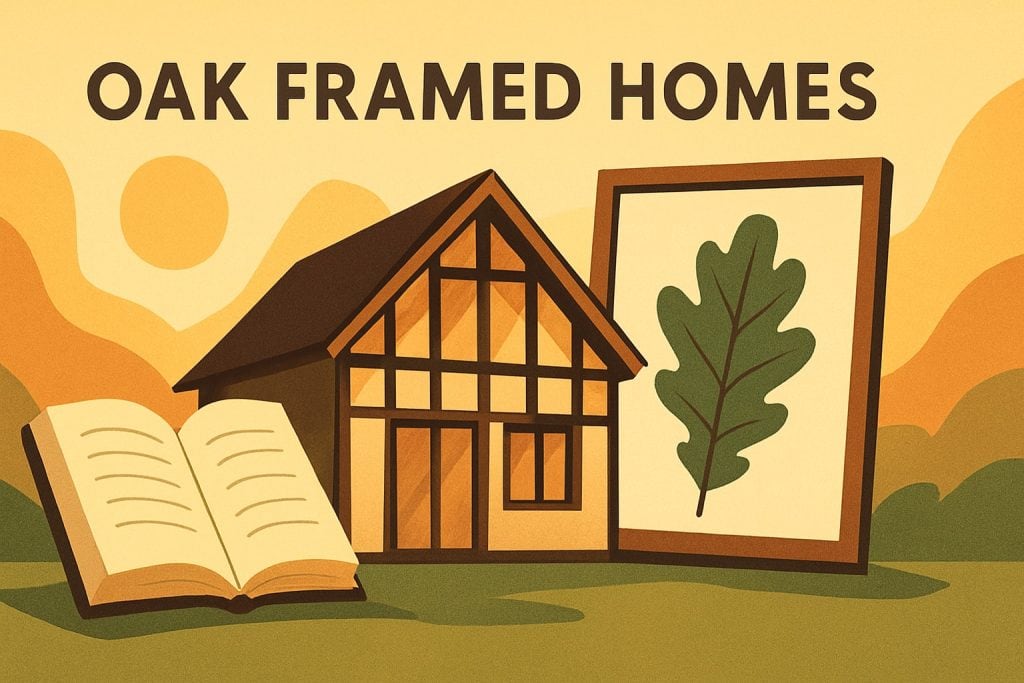Imagine stepping into a space where tradition meets innovation and every beam tells a story. Oak framed homes have captured the imagination of homeowners and builders alike, offering a blend of heritage and sustainability that defines modern living in 2025.
This essential guide is your gateway to understanding oak framed homes. Discover their lasting appeal, explore the latest design trends, and learn how modern construction techniques are making these structures more accessible and energy efficient.
We will walk you through the unique benefits, planning essentials, construction steps, costs, and future trends. Whether you are dreaming, designing, or ready to build, this guide will help you navigate every stage of your oak framed home journey.
The Enduring Appeal of Oak Framed Homes
Imagine stepping inside a house where every beam tells a story, and the architecture connects past and present. This is the essence of oak framed homes, which have stood as icons of British design for centuries. Their enduring appeal lies not just in their looks, but in a blend of tradition, sustainability, and innovation that continues to attract homeowners in 2025.
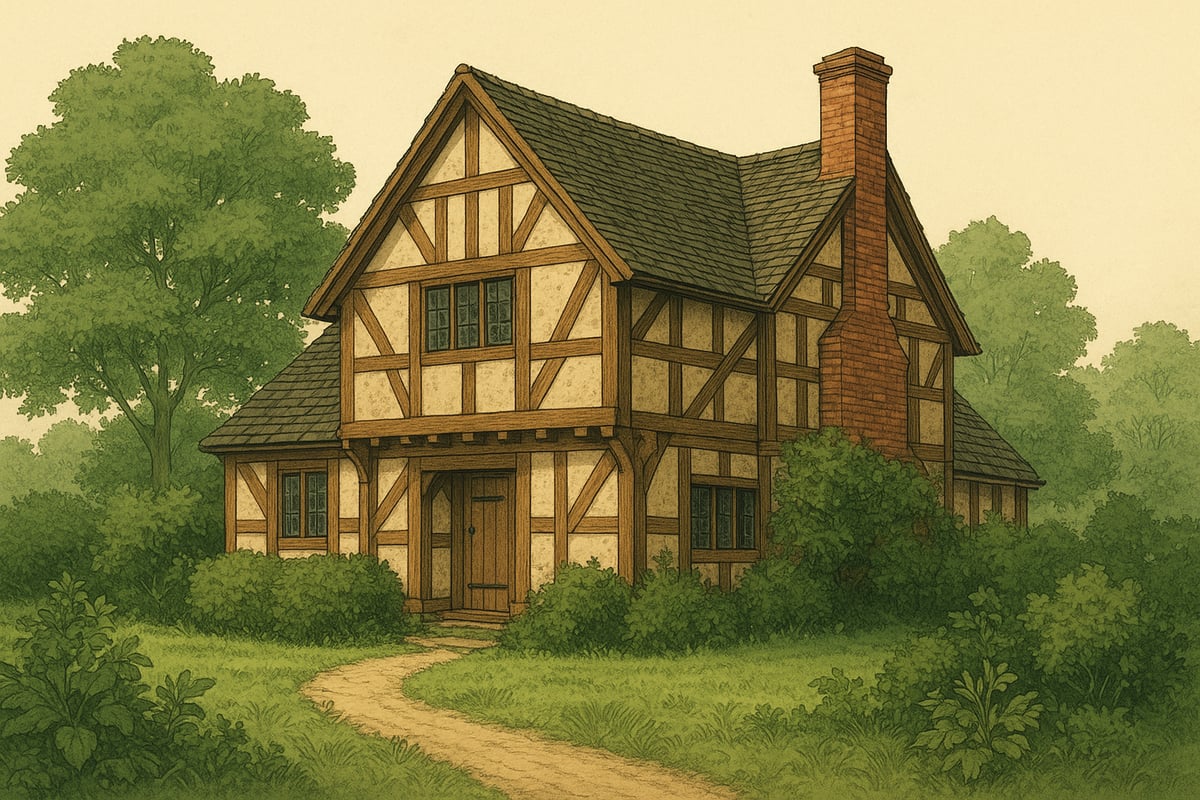
Historical Significance and Timeless Aesthetics
Oak framed homes have deep roots in the UK’s architectural history. Medieval timber structures, such as those found in Chester and York, still stand today, their exposed beams radiating character and warmth. These homes are not just buildings, but living pieces of heritage. The unique grain and patina of oak develop with age, creating a visual richness that modern materials struggle to match. Homeowners are drawn to the artistry of traditional joinery and the sense of continuity that oak framed homes provide.
Structural Strength and Longevity
One of the most valued qualities of oak framed homes is their exceptional strength. Oak is naturally dense and resistant to pests and decay, making it ideal for structural use. There are numerous examples of oak homes that have lasted more than 300 years, a testament to their lasting power. Compared to softwood or steel, oak offers a unique combination of durability and flexibility. This resilience means that oak framed homes can withstand the British climate while maintaining their beauty for generations.
- Oak: Dense, durable, and pest-resistant
- Softwood: Less durable, more susceptible to rot
- Steel: Strong, but lacks the warmth and heritage of oak
Sustainability and Environmental Benefits
Sustainability is at the heart of modern oak framed homes. Oak is a renewable resource, carefully managed under strict UK and EU forestry regulations. This ensures that each tree felled is replaced, supporting healthy woodlands. The embodied carbon of an oak frame is significantly lower than that of brick or concrete, making it a greener option. In 2025, there is growing demand for reclaimed and FSC-certified oak, reflecting a commitment to responsible sourcing and environmental stewardship.
Energy Efficiency and Living Comfort
Oak framed homes offer impressive energy efficiency due to the timber’s natural insulating properties. When combined with advanced insulation and high-performance glazing, these homes can achieve substantial energy savings. According to the UK Green Building Council, energy bills in oak framed homes can be reduced by up to 25 percent compared to conventional construction. This translates to a more comfortable living environment, with stable indoor temperatures and a reduced carbon footprint.
Customisation and Bespoke Design
Flexibility is another hallmark of oak framed homes. The structural properties of oak allow for open-plan layouts, soaring vaulted ceilings, and dramatic glazing that brings the outdoors in. Whether designing a contemporary home, an extension, or a garden outbuilding, the possibilities are almost limitless. In 2025, homeowners are embracing modern design trends such as minimalist detailing, expansive glass, and eco-friendly finishes, all while enjoying the timeless appeal of exposed oak.
Enhanced Property Value and Market Demand
The prestige and character of oak framed homes place them at a premium in the UK property market. Recent statistics show these homes can command up to 15 percent higher resale values compared to standard builds. Buyers appreciate the blend of tradition, sustainability, and bespoke design. The enduring appeal of oak framed buildings, including their durability and aesthetic value, continues to drive strong demand, as highlighted in Oak Framed Buildings: Maximise Space & Value in 2025. As a result, oak framed homes remain a smart investment for those seeking both financial and lifestyle rewards.
Planning and Designing Your Oak Framed Home
Planning and designing oak framed homes in 2025 is both an exciting and rewarding journey. Whether you are a homeowner, self-builder, or property developer, understanding each stage of the process ensures your dream home will be both beautiful and functional. Here is what you need to consider at every step.
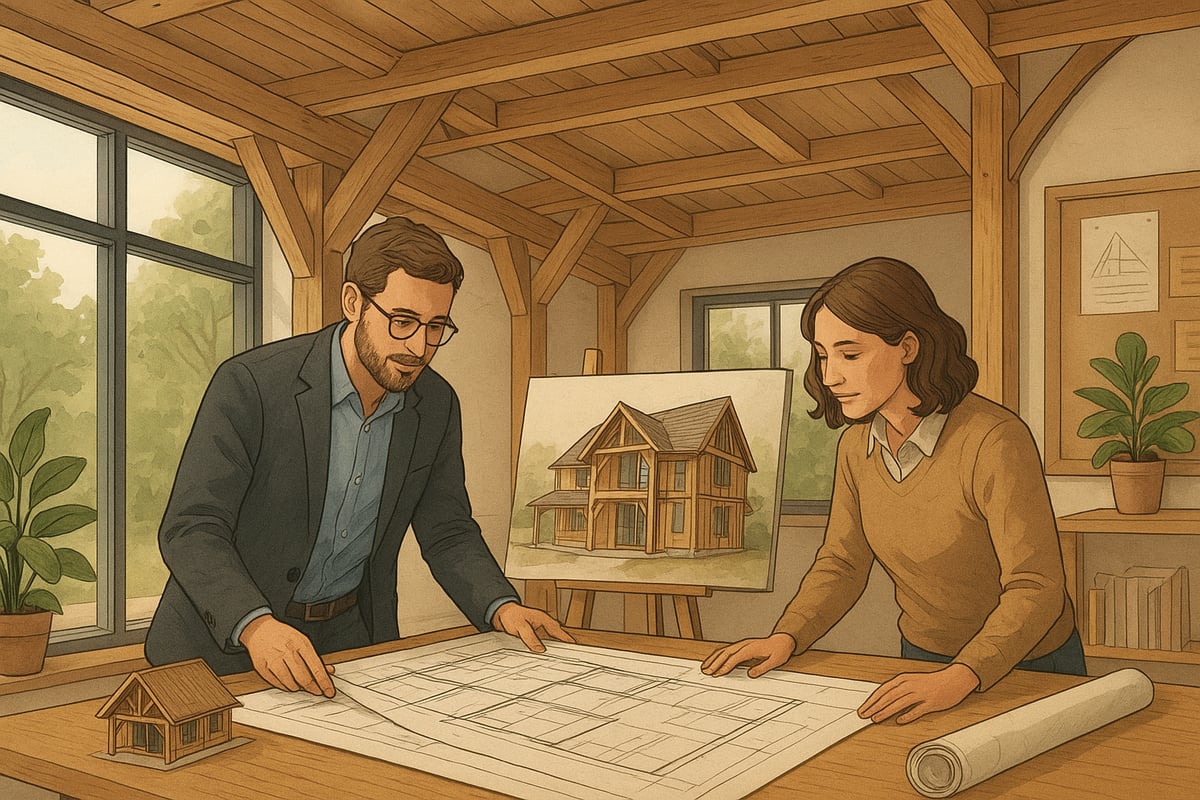
Key Considerations Before You Begin
The first step in planning oak framed homes is selecting a suitable plot. Assess access for large deliveries and consider the site’s orientation for natural light. Early research on planning permission and building regulations is crucial. The UK has specific requirements for timber construction, so seek pre-application consultations with local authorities for smoother approvals.
List of initial considerations:
- Plot access for heavy vehicles
- Local planning policies for timber structures
- Environmental and heritage constraints
Understanding these factors at the outset will help you avoid delays and unexpected costs. Oak framed homes are unique, and early preparation sets the foundation for success.
Working with Architects and Designers
Collaborating with experienced professionals is vital for oak framed homes. Engage architects and designers who specialise in oak framing, as their expertise ensures your home balances traditional aesthetics with modern needs. Oak frames offer flexibility, allowing for open layouts, vaulted ceilings, and generous glazing.
Effective teamwork between architects, engineers, and clients leads to a truly bespoke result. For those looking to explore custom possibilities, bespoke oak frame design services can unlock innovative solutions and unique features tailored to your lifestyle.
Open discussions about your vision and requirements will help your team deliver a home that is both timeless and tailored.
Design Trends for 2025
In 2025, oak framed homes embrace a blend of tradition and modernity. Popular styles include barn conversions with exposed beams, contemporary minimalist layouts, and hybrid designs that mix oak with glass or steel. Large glazed areas and open-plan living are highly sought after, bringing natural light and a sense of space.
Sustainable materials and smart home technology are now standard considerations. Homeowners increasingly choose oak framed homes for their ability to support eco-friendly features without sacrificing style or comfort.
Stay informed about current trends to ensure your home remains attractive and future-proof.
Sustainability in Design
Sustainability is central to the design of oak framed homes. Maximising passive solar gain by orienting glazing to the south, and designing for natural ventilation, can significantly lower energy use. Choose eco-friendly finishes, recycled materials, and high-performance insulation to enhance green credentials.
Aim for an EPC A rating and meet the Future Homes Standard, which is now a benchmark for new builds. Responsible sourcing of oak, such as FSC-certified timber, guarantees minimal environmental impact while supporting biodiversity.
Thoughtful design choices make oak framed homes comfortable, efficient, and environmentally friendly for years to come.
Budgeting and Project Planning
Accurate budgeting is essential when building oak framed homes. Costs typically range from £2,000 to £2,500 per square metre, depending on design complexity, location, and specification. Allow for contingencies, as bespoke features or unexpected site issues can affect the final budget.
Table: Average Costs Breakdown (2025)
| Element | Cost per m² (£) |
|---|---|
| Oak Frame | 600–900 |
| Foundations | 120–200 |
| Infill & Cladding | 200–300 |
| Fit-Out | 400–600 |
| Professional Fees | 150–250 |
Plan your project timeline carefully, factoring in lead times for oak frame fabrication and potential phased construction. Early financial planning supports a smoother build and helps you make informed decisions.
Acorn to Oak Framing: Your Oak Frame Specialist
Choosing the right partner is key to realising your oak framed homes vision. Acorn to Oak Framing stands out as a leading UK provider, offering bespoke design services, ready-to-go kits, and a strong commitment to sustainability. Their team combines traditional craftsmanship with modern methods, ensuring every project meets the highest standards.
Clients benefit from comprehensive support, from initial consultation to completion. Acorn to Oak Framing’s regulatory expertise and focus on client satisfaction have resulted in a portfolio of stunning, high-quality oak framed homes across the country.
By working with specialists like Acorn to Oak Framing, you gain peace of mind and a home that reflects your values and aspirations.
Step-by-Step Construction Process for Oak Framed Homes
Embarking on the construction of oak framed homes involves a series of carefully coordinated stages, each vital for achieving a residence that stands the test of time. The process combines traditional methods with modern best practices, ensuring strength, efficiency, and enduring beauty. For a deeper dive into each stage, you can explore this comprehensive oak frame construction process guide.
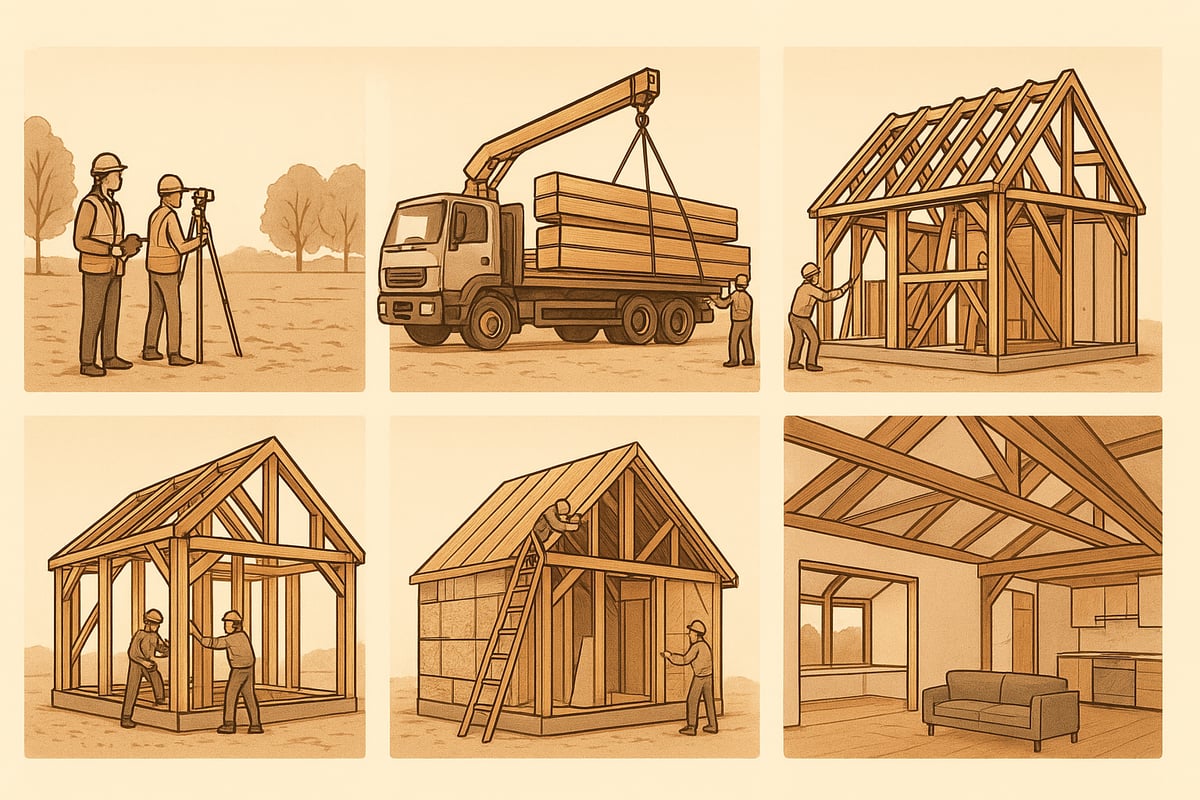
Step 1: Site Preparation and Foundations
The first step for oak framed homes is meticulous site preparation. This includes detailed surveys to assess ground conditions, drainage, and access. Once the site is cleared and levelled, foundations are laid. Common types for oak framed homes include raft, strip, and pile foundations, chosen based on soil type and structural load.
Key considerations:
- Accurate site surveys to identify potential issues early
- Selecting the right foundation to support the weight of oak framed homes
- Ensuring utilities are planned before concrete is poured
Proper foundations are essential for structural integrity, helping oak framed homes remain stable for generations.
Step 2: Frame Fabrication and Delivery
In this stage, the oak beams for oak framed homes are sourced, seasoned, and precision-cut, often off-site in specialist workshops. Quality control is paramount to guarantee the strength and longevity of the frame. Each component is labelled for efficient assembly.
Key steps include:
- Choosing sustainably sourced or reclaimed oak
- Seasoning timber to minimise future movement
- Prefabricating joints to reduce on-site waste
Careful planning ensures that when the frame is delivered, it arrives in perfect condition, ready for swift assembly on site.
Step 3: Frame Erection and Assembly
The heart of oak framed homes lies in the assembly of the frame. Traditional mortise and tenon joinery, secured with oak pegs, is often combined with discreet modern fixings for added strength. Erection typically takes one to two weeks for a standard house, depending on complexity and weather.
During this phase:
- The frame is lifted and positioned using cranes
- Each joint is checked for fit and alignment
- Temporary weatherproofing is applied to protect the structure
This stage brings the distinctive silhouette and character of oak framed homes to life.
Step 4: Enclosing the Structure
Once the frame stands, it is enclosed to protect it from the elements and improve energy efficiency. Oak framed homes can use several wall infill systems, such as SIPs (structural insulated panels), brick, block, or timber cladding, depending on design and budget.
Tasks at this stage:
- Installing insulated wall panels or traditional infill
- Constructing the roof with insulation and waterproof membranes
- Fitting windows, doors, and large areas of glazing
A well-enclosed structure ensures oak framed homes are comfortable, weather-resistant, and energy efficient.
Step 5: Internal Fit-Out and Finishing
With the structure enclosed, attention turns to the interior of oak framed homes. Carpentry teams carry out first and second fix work, including stairs, flooring, and joinery. Electrical, plumbing, and heating systems are installed.
Finishing touches include:
- Plastering or cladding internal walls
- Decorating to complement exposed oak beams
- Installing kitchens, bathrooms, and bespoke joinery
Careful finishing ensures the unique character of oak framed homes is showcased in every room.
Quality Assurance and Inspections
Quality assurance is critical throughout the construction of oak framed homes. Building control officers visit at key stages to inspect foundations, structural integrity, and compliance with UK regulations. Regular checks help identify and resolve issues early.
Checklist for quality:
- Confirming all timber is defect-free and correctly installed
- Verifying insulation and airtightness standards
- Ensuring all work meets building regulations
By prioritising quality and thorough inspections, homeowners can have confidence that their oak framed homes will deliver comfort, value, and longevity.
Costs, Financing, and Value of Oak Framed Homes
Understanding the costs, financing options, and long-term value of oak framed homes is crucial for anyone considering this investment. Each financial aspect, from the initial build to future resale, can influence your decision and the overall success of your project.
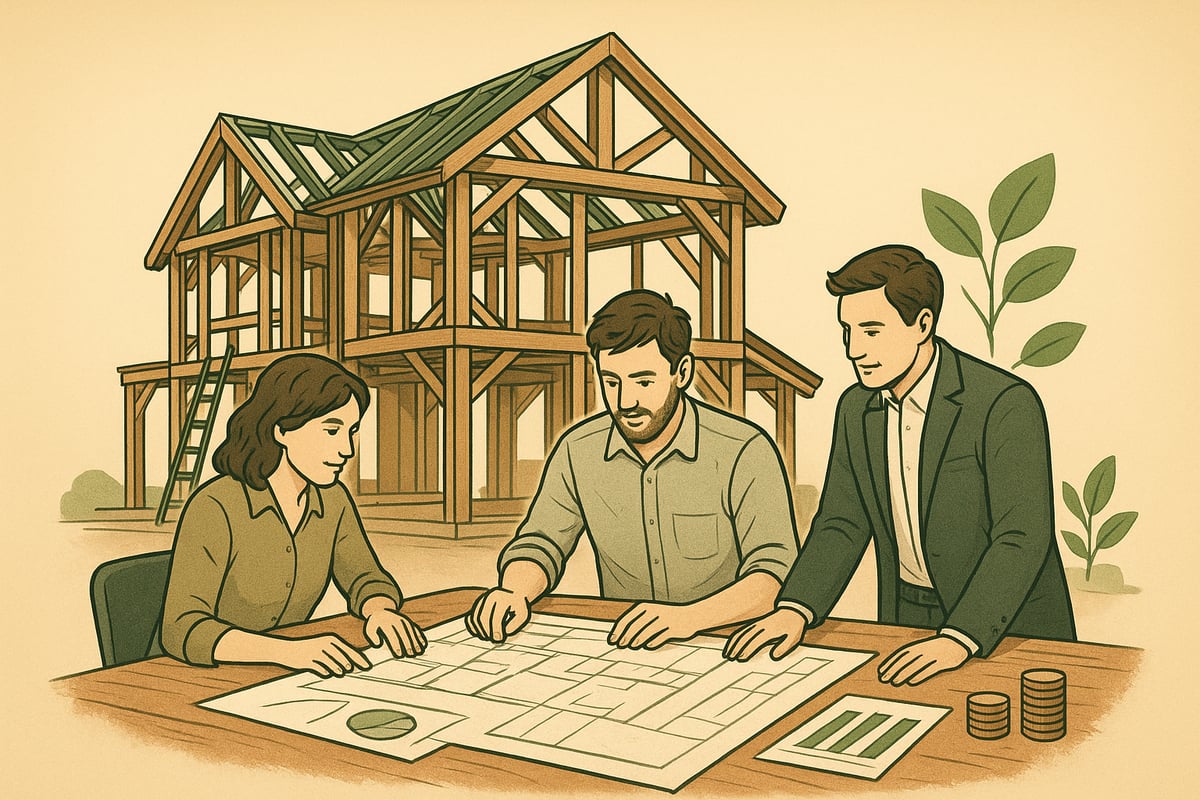
Initial Build Costs and Influencing Factors
The initial outlay for oak framed homes varies based on design, location, and specification. On average, expect costs between £2,000 and £2,500 per square metre in 2025. Factors such as bespoke features, complexity, and regional labour rates can affect this range.
| Build Type | Average Cost (£/m²) | Typical Range (£/m²) |
|---|---|---|
| Oak Framed Homes | 2,250 | 2,000–2,500 |
| Brick/Block Homes | 1,800 | 1,500–2,100 |
| Timber Frame Homes | 1,700 | 1,400–2,000 |
Material choice, frame complexity, and site conditions all play a role. For a detailed cost breakdown, see Oak Frame House Prices: A Comprehensive Guide to Costs. Always budget for contingencies and professional fees when planning oak framed homes.
Financing Options and Self-Build Mortgages
Financing oak framed homes requires careful preparation. In 2025, self-build mortgages are widely available, designed to release funds at key project stages rather than as a lump sum. This staged approach aligns with the unique construction sequence of oak framed homes.
Major UK lenders offer competitive self-build products. Lenders typically require detailed plans, planning permission, and fixed-price contracts before approving funding. Expect to provide a deposit of 15-25%. Typical interest rates are slightly higher than standard mortgages, reflecting the perceived risk and complexity.
Preparing thorough documentation and working with an experienced broker can streamline the process. Ensure your financial plan accounts for every stage of building oak framed homes to avoid cash flow issues.
Running Costs and Long-Term Value
Oak framed homes are renowned for their low running costs and exceptional durability. Thanks to oak’s natural insulating properties, combined with modern insulation and glazing, energy bills can be up to 25% lower compared to conventional builds.
Maintenance requirements are typically modest, as oak is highly resistant to pests and decay. Over a 30-year period, the average annual maintenance cost for oak framed homes is estimated at £800, versus £1,100 for brick homes. This long-term saving, paired with reduced energy use, makes oak framed homes an appealing financial choice.
Owners also benefit from the enduring value and structural integrity that oak provides, ensuring the home remains comfortable and efficient for generations.
Resale Value and Market Trends
Oak framed homes command a premium in the UK property market. Their distinctive character, sustainability credentials, and bespoke design features drive strong buyer demand. Data from UK estate agents shows that oak framed homes can achieve up to 15% higher resale values compared to conventional properties.
On average, these homes spend less time on the market, appealing to buyers seeking unique architecture and eco-friendly living. The market outlook for oak framed homes remains positive, with increasing interest from both families and downsizers. This trend is expected to continue as sustainability becomes a central factor in property decisions.
Grants, Incentives, and VAT Relief
Building oak framed homes often qualifies for a range of government incentives. New build projects are typically exempt from VAT on construction costs, offering significant savings. Self-builders can claim this relief by submitting detailed invoices and evidence upon project completion.
Additional grants may be available for sustainable features such as solar panels, heat pumps, or high-performance insulation. Check with local authorities and national schemes for current offers. Understanding and applying for these incentives can reduce the upfront cost of oak framed homes and support your investment in sustainable living.
Innovations and Future Trends in Oak Framed Homes
The world of oak framed homes is experiencing a renaissance, with new technologies and design philosophies shaping the way these timeless structures are conceived and built. As we look ahead to 2025, both tradition and innovation are driving the evolution of oak framed homes. Whether you are a self-builder or developer, staying informed about these trends will help you make the most of your investment.
Advanced Construction Techniques
One of the most significant shifts in oak framed homes is the rise of modular and prefabricated building methods. These approaches allow entire oak frames to be crafted off-site, with precision engineering ensuring every joint and beam fits perfectly. This not only speeds up construction but also enhances quality and minimises waste.
Hybrid construction is another trend, with oak being combined with steel, glass, or engineered timber to create striking architectural features. Digital design tools, such as 3D modelling, are now standard, letting clients visualise their oak framed homes before a single beam is cut. For a closer look at the latest design movements, explore the Top 5 Oak Framing Design Trends for 2025.
Sustainability and Environmental Advances
Sustainability remains at the forefront of innovation in oak framed homes. With the UK targeting net-zero carbon construction, more projects are embracing reclaimed and thermally modified oak. These materials offer the same beauty and strength, while dramatically reducing environmental impact.
The circular economy is gaining ground, with offcuts and surplus timber being repurposed for other building elements. Homeowners and developers are increasingly seeking FSC certification and transparent supply chains to ensure their oak framed homes contribute positively to reforestation and biodiversity.
Smart Home Integration
The integration of smart technology is transforming how oak framed homes are lived in. Automated lighting, heating, and security systems can now be seamlessly incorporated into both traditional and contemporary designs. Renewable energy sources, including solar panels, heat pumps, and battery storage, are becoming standard features.
Imagine controlling your oak framed home’s comfort, security, and energy consumption from your smartphone. These smart integrations not only enhance daily living but also support long-term sustainability goals.
Urban and Rural Applications
Oak framed homes are no longer limited to countryside plots. Urban infill sites are increasingly being developed with sustainable timber structures, reflecting a shift in planning policy and public attitudes. In cities, oak framed homes offer a unique blend of character and modern efficiency, while in rural areas, they remain symbols of heritage and craftsmanship.
Examples of urban oak framed developments are emerging in towns across the UK, proving the versatility and enduring appeal of these homes in a variety of settings.
Market Outlook and Buyer Preferences
The market for oak framed homes is set for strong growth from 2025 onwards. Demographic shifts, such as more eco-conscious buyers and younger families seeking long-term value, are fuelling demand. Industry reports predict continued expansion, supported by evolving regulations and greater availability of sustainable materials.
For further insight into why timber-framed and oak framed homes are becoming a dominant trend, see Why Are Timber-Framed Houses A Growing Trend In The UK For 2025. As these homes become more accessible and desirable, now is an ideal time to consider their benefits for your next build.
Frequently Asked Questions About Oak Framed Homes
Curious about what it is like to own or build oak framed homes? Here, we answer some of the most common questions, drawing on expert knowledge and practical experience. For even more detailed answers, visit the Oak framed home FAQs page.
Common Concerns and Misconceptions
A frequent question is whether oak framed homes move or crack as they age. All timber frames experience some natural movement, but seasoned oak is chosen specifically for its stability. Minor splits, known as shakes, are normal and do not affect structural integrity. Insurance costs are typically similar to other high-quality homes, though it is wise to consult your provider.
Maintenance and Care
Maintaining oak framed homes is straightforward. Exposed beams may develop surface splits over time, which can be left for character or treated with specialist oils as needed. Cleaning involves gentle dusting or vacuuming. Periodic checks for moisture or pests are sensible, but oak’s natural resistance means treatments are rarely required. Professional inspections can extend longevity.
Customisation and Extensions
One of the main attractions of oak framed homes is flexibility. Extensions, annexes, garages, and outbuildings can be seamlessly integrated if designed by specialists. The bespoke nature of oak construction allows for future adaptation, whether you want to expand your living space or add new features. Always consult professionals to match the original style.
Regulatory and Legal Aspects
Oak framed homes must comply with all UK building regulations. This includes structural safety, fire resistance, and energy efficiency standards. If your property is listed or in a conservation area, additional permissions may be required. Many oak frame providers offer guidance through these processes, ensuring your home meets every legal requirement.
Sourcing Oak and Environmental Impact
Responsible sourcing is vital for oak framed homes. Always insist on timber that is FSC-certified or reclaimed to ensure environmental stewardship. Modern forestry practices in the UK and EU support biodiversity and reforestation. Choosing sustainable oak reduces your home’s carbon footprint and aligns with eco-friendly building goals.
Now that you have a clearer understanding of the beauty, sustainability, and investment potential of oak framed homes in 2025, you may be thinking about how to bring your own vision to life. Whether you are dreaming of a bespoke oak home, a stunning extension, or a practical outbuilding, we are here to guide you every step of the way. With our expertise in traditional craftsmanship, modern design, and sustainable building practices, you can trust us to create a space that truly reflects your lifestyle and values. If you are ready to take the next step, BUILD NOW.
